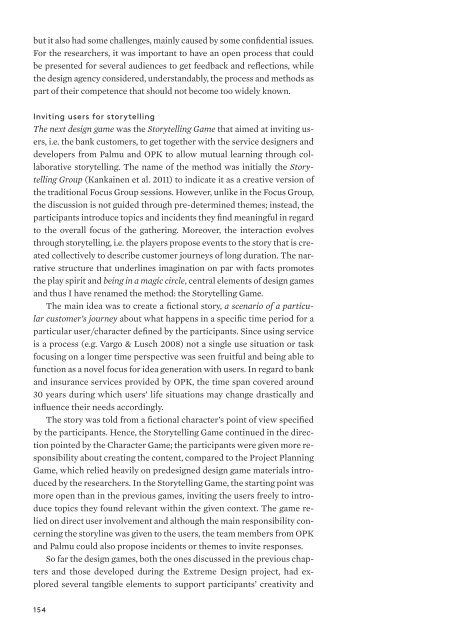Design games as a tool, a mindset and a structure Kirsikka Vaajakallio
Design games as a tool, a mindset and a structure Kirsikka Vaajakallio
Design games as a tool, a mindset and a structure Kirsikka Vaajakallio
You also want an ePaper? Increase the reach of your titles
YUMPU automatically turns print PDFs into web optimized ePapers that Google loves.
ut it also had some challenges, mainly caused by some confidential issues.<br />
For the researchers, it w<strong>as</strong> important to have an open process that could<br />
be presented for several audiences to get feedback <strong>and</strong> reflections, while<br />
the design agency considered, underst<strong>and</strong>ably, the process <strong>and</strong> methods <strong>as</strong><br />
part of their competence that should not become too widely known.<br />
Inviting users for storytelling<br />
The next design game w<strong>as</strong> the Storytelling Game that aimed at inviting users,<br />
i.e. the bank customers, to get together with the service designers <strong>and</strong><br />
developers from Palmu <strong>and</strong> OPK to allow mutual learning through collaborative<br />
storytelling. The name of the method w<strong>as</strong> initially the Storytelling<br />
Group (Kankainen et al. 2011) to indicate it <strong>as</strong> a creative version of<br />
the traditional Focus Group sessions. However, unlike in the Focus Group,<br />
the discussion is not guided through pre-determined themes; instead, the<br />
participants introduce topics <strong>and</strong> incidents they find meaningful in regard<br />
to the overall focus of the gathering. Moreover, the interaction evolves<br />
through storytelling, i.e. the players propose events to the story that is created<br />
collectively to describe customer journeys of long duration. The narrative<br />
<strong>structure</strong> that underlines imagination on par with facts promotes<br />
the play spirit <strong>and</strong> being in a magic circle, central elements of design <strong>games</strong><br />
<strong>and</strong> thus I have renamed the method: the Storytelling Game.<br />
The main idea w<strong>as</strong> to create a fictional story, a scenario of a particular<br />
customer’s journey about what happens in a specific time period for a<br />
particular user/character defined by the participants. Since using service<br />
is a process (e.g. Vargo & Lusch 2008) not a single use situation or t<strong>as</strong>k<br />
focusing on a longer time perspective w<strong>as</strong> seen fruitful <strong>and</strong> being able to<br />
function <strong>as</strong> a novel focus for idea generation with users. In regard to bank<br />
<strong>and</strong> insurance services provided by OPK, the time span covered around<br />
30 years during which users’ life situations may change dr<strong>as</strong>tically <strong>and</strong><br />
influence their needs accordingly.<br />
The story w<strong>as</strong> told from a fictional character’s point of view specified<br />
by the participants. Hence, the Storytelling Game continued in the direction<br />
pointed by the Character Game; the participants were given more responsibility<br />
about creating the content, compared to the Project Planning<br />
Game, which relied heavily on predesigned design game materials introduced<br />
by the researchers. In the Storytelling Game, the starting point w<strong>as</strong><br />
more open than in the previous <strong>games</strong>, inviting the users freely to introduce<br />
topics they found relevant within the given context. The game relied<br />
on direct user involvement <strong>and</strong> although the main responsibility concerning<br />
the storyline w<strong>as</strong> given to the users, the team members from OPK<br />
<strong>and</strong> Palmu could also propose incidents or themes to invite responses.<br />
So far the design <strong>games</strong>, both the ones discussed in the previous chapters<br />
<strong>and</strong> those developed during the Extreme <strong>Design</strong> project, had explored<br />
several tangible elements to support participants’ creativity <strong>and</strong><br />
154
















